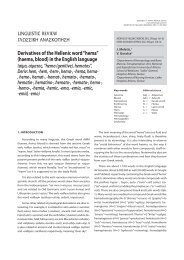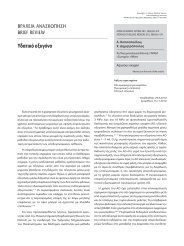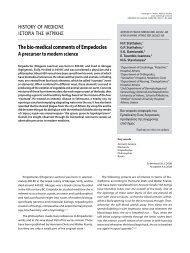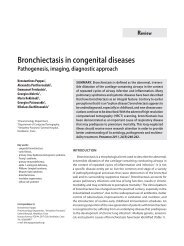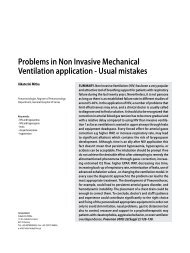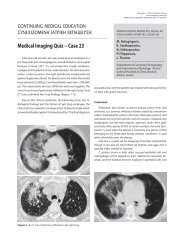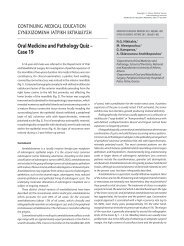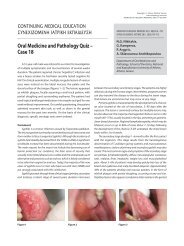Favism A brief history from the “abstain from beans”
Favism A brief history from the “abstain from beans”
Favism A brief history from the “abstain from beans”
You also want an ePaper? Increase the reach of your titles
YUMPU automatically turns print PDFs into web optimized ePapers that Google loves.
HISTORY OF MEDICINE<br />
��������������������<br />
<strong>Favism</strong><br />
A <strong>brief</strong> <strong>history</strong> <strong>from</strong> <strong>the</strong> <strong>“abstain</strong> <strong>from</strong> <strong>beans”</strong><br />
of Pythagoras to <strong>the</strong> present<br />
<strong>Favism</strong> is a form of hemolytic anemia and jaundice following <strong>the</strong> intake of<br />
fava beans and o<strong>the</strong>r legumes and various drugs. It is caused by a hereditary<br />
abnormality of <strong>the</strong> red cell enzyme glucose-6-phosphate dehydrogenase<br />
(G6PD). The condition is common in <strong>the</strong> Mediterranean basin. Various<br />
disturbances caused by fava beans, and especially toxic hemolytic anemia,<br />
have been recognized even <strong>from</strong> <strong>the</strong> period of Pythagoras, and <strong>the</strong> adage “be<br />
far <strong>from</strong> <strong>the</strong> consumption of fava <strong>beans”</strong> constitutes part of his consultations.<br />
<strong>Favism</strong> (favisme, fabismus, favismo, fabism) is a reaction<br />
to <strong>the</strong> ingestion of <strong>the</strong> fava plant, its beans, pods and,<br />
most likely, foliage, or to inhalation of fava pollen. It is<br />
due to a hereditary abnormality of <strong>the</strong> red cell enzyme<br />
glucose-6-phosphate dehydrogenase (G6PD), which can<br />
cause sudden destruction of <strong>the</strong> red cell with hemolytic<br />
anemia and jaundice following <strong>the</strong> intake of fava beans,<br />
o<strong>the</strong>r legumes or various drugs. <strong>Favism</strong> is common in <strong>the</strong><br />
Mediterranean area, Africa and sou<strong>the</strong>rn Asia. More than<br />
400 genetic variants have now been recognized.<br />
The consumption of fava beans originated in <strong>the</strong> Near<br />
East in late Neolithic times and later <strong>the</strong>y were cultivated in<br />
ancient Egypt, Greece and Rome. Fava beans are mentioned<br />
several times in <strong>the</strong> Iliad of Homer (8th to 9th century BC). 1,2<br />
The ancient Greeks apparently associated <strong>the</strong> little black<br />
spot on <strong>the</strong> hilum of <strong>the</strong> bean with death and, although<br />
<strong>the</strong> beans were sometimes offered in sacrifices to Apollo,<br />
<strong>the</strong> priests were strictly forbidden to eat <strong>the</strong> fava bean or<br />
ARCHIVES OF HELLENIC MEDICINE 2012, 29(2):258-263<br />
ÁÑ×ÅÉÁ ÅËËÇÍÉÊÇÓ ÉÁÔÑÉÊÇÓ 2012, 29(2):258-263<br />
...............................................<br />
J. Meletis<br />
...............................................<br />
Department of Hematology and Bone<br />
Marrow Transplantation Unit, National<br />
and Kapodistrian University of A<strong>the</strong>ns,<br />
School of Medicine, “Laiko” General<br />
Hospital, A<strong>the</strong>ns, Greece<br />
Κυαμισμός – βραχεία ιστορική<br />
αναδρομή από το «κυάμων<br />
απέχεσθαι» του Πυθαγόρα<br />
έως σήμερα<br />
Key words<br />
Copyright � A<strong>the</strong>ns Medical Society<br />
www.mednet.gr/archives<br />
ARCHIVES OF HELLENIC MEDICINE: ISSN 11-05-3992<br />
<strong>Favism</strong><br />
Glucose-6-phosphate<br />
dehydrogenase deficiency<br />
G6PD<br />
Pythagoras<br />
Περίληψη στο τέλος του άρθρου<br />
Submitted 10.11.2011<br />
Accepted 30.11.2011<br />
«…κυάμων απέχεσθαι…», “…kyamon apechehes<strong>the</strong>…”<br />
“…be far <strong>from</strong> <strong>the</strong> consumption of fava beans …”<br />
(part of Pythagorean consultations)<br />
even to mention its name. Unlike <strong>the</strong> Egyptians and Greeks,<br />
<strong>the</strong> Romans held <strong>the</strong> fava beans in high esteem among<br />
legumes. The beans referred to by Pythagoras (c. 570 to c.<br />
495 BC) are fava beans (vicia fava, vica faba vulgaris), which<br />
botanically are classified as a large seeded vetch. The plant<br />
is well adapted to <strong>the</strong> Mediterranean region because it is<br />
very hardy to <strong>the</strong> cold and grows vigorously during <strong>the</strong><br />
cool wet months of winter. There is evidence that it has for<br />
centuries been a unique and invaluable part of <strong>the</strong> diet of<br />
<strong>the</strong> people living in <strong>the</strong> Mediterranean basin. Its <strong>history</strong> is<br />
redolent with superstition, prohibition, magic and fear. 3−18<br />
It is well known that for some people fresh fava beans<br />
can be poisonous. Although common and known of for<br />
centuries, favism as a genetically transmitted disease was<br />
recognized only at <strong>the</strong> beginning of <strong>the</strong> 20th century and<br />
its mechanism was fully explained only in <strong>the</strong> last decades.<br />
In Classical Greece doctors had seen <strong>the</strong> importance
HISTORY OF FAVISM 259<br />
of <strong>the</strong> environment, natural elements and “aliments” for<br />
maintaining <strong>the</strong> right balance of <strong>the</strong> organism. The occurrence<br />
of hemolytic anemia in individuals due to lack of <strong>the</strong><br />
enzyme G6PD was known about for many years. It was<br />
called “favism”, relating its occurrence to <strong>the</strong> consumption<br />
of fava beans (<strong>the</strong> corresponding Greek words are «κύαμοι»,<br />
(“kyamoi”), «κυαμισμός» (“kyamismos”, i.e., favismus). The<br />
observation that <strong>the</strong> consumption of fava beans causes<br />
various disturbances was <strong>the</strong> first instance of recognition of<br />
toxic hemolytic anemia and <strong>the</strong> rule «κυάμων απέχεσθαι»<br />
(“kyamon apeches<strong>the</strong>”), “be far <strong>from</strong> <strong>the</strong> consumption of fava<br />
<strong>beans”</strong>, constitutes part of Pythagorean consultations. 10,19−28<br />
This rule restricted <strong>the</strong> consumption of a legume that is<br />
named <strong>the</strong> Greek fava bean (kyamos Hellenikos, Vicia fava,<br />
Vica faba) that had already been cultivated and used in<br />
<strong>the</strong> Mediterranean since <strong>the</strong> Prehistoric era. Theophrastus<br />
(372 to c. 285 BC) 29 used <strong>the</strong> word kyamos (vicia fava) to<br />
characterize <strong>the</strong> plant as well its kernel. Pliny (23 to 79<br />
AD) 30,31 and Dioscorides (40 to 90 AD) 32 separated <strong>the</strong><br />
Greek fava been <strong>from</strong> <strong>the</strong> fava Aegyptia, pointing out that<br />
<strong>the</strong> Pythagorean rule concerns only <strong>the</strong> Greek fava bean.<br />
Empedocles (495 to 435 BC) 33−36 during <strong>the</strong> 5th century<br />
BC continued <strong>the</strong> Pythagorean teaching declaring that<br />
«δειλοί, πάνδειλοι, κυάμων από χείρας έχεσθαι», “deiloi,<br />
pandeiloi, kyamon apo cheiras eches<strong>the</strong>” – “unhappy, lot of<br />
miserables, not touched by fava <strong>beans”</strong>. Kallimachos (310<br />
to 240 BC) during <strong>the</strong> 3rd century BC wrote «και κυάμων<br />
από χείρας έχεις, ανιόντος εδεστού, καγώ Πυθαγόρας<br />
ως εκέλευε» “kai kyamon apo cheiras echeis, aniontos<br />
edestou, kago Pythagoras os ekeleve”– “I say also, as said<br />
Pythagoras, you do not touch upon fava beans, that is<br />
corroded food”. 37 Pythagoras refused to walk through fields<br />
of fava beans and forbade his disciples to eat <strong>the</strong>m. He is<br />
said to have met his death at <strong>the</strong> hands of <strong>the</strong> people of<br />
Crotonia in Ancient Italy. 38,39 Pursued by <strong>the</strong>m, Pythagoras<br />
died at <strong>the</strong> hands of his enemies because he would not<br />
flee across a bean field, he came to <strong>the</strong> edge of a bean<br />
field and, ra<strong>the</strong>r than set foot in it, was caught and killed<br />
as reported by Artemidoros (1st century BC), Cicero (106 to<br />
43 BC), Iamblichus (c. 245 to c. 325 AD), Diogenes Laertios<br />
(c. 3rd century AD), Pausanias (2nd century AD), Porphyry<br />
(234 to early 4th century AD) and Grigorios Nanzyanzynos<br />
(329 to 390 AD). 20,40−45 Iamblichus tells of <strong>the</strong> time when<br />
some Pythagoreans were being pursued by <strong>the</strong>ir enemies<br />
and <strong>the</strong>y came across a field of fava bean plants in bloom.<br />
Ra<strong>the</strong>r than disobey <strong>the</strong>ir master’s dictates and flee through<br />
<strong>the</strong> field, <strong>the</strong>y were slaughtered, and when two who<br />
were captured were questioned about <strong>the</strong>ir beliefs, <strong>the</strong>y<br />
refused to answer. The husband chose death and <strong>the</strong> wife,<br />
a Spartan, bit off her tongue and spit it at her captors to<br />
avoid “spilling <strong>the</strong> <strong>beans”</strong>. 22<br />
Τhe rejection of fava beans is also reported by philosophers<br />
of India constituting very probably prevention lauded by<br />
<strong>the</strong> Greeks. Whe<strong>the</strong>r or not poisoning was <strong>the</strong> basis of<br />
Pythagoras’ pronouncement, for many this argument is not<br />
certain. This debate is well summed up by Aristotle (384<br />
to 322 BC) and Aulus Gelius (c. 125 to c. 180 AD), who say<br />
that Pythagoras proscribed fava beans ei<strong>the</strong>r because <strong>the</strong>y<br />
look like genitals (testicles), or because <strong>the</strong>y resemble <strong>the</strong><br />
gate of Hades, for <strong>the</strong>y alone have no joints, since <strong>the</strong>se<br />
two correlate well with traits connecting beans with human<br />
life and generation referred to by o<strong>the</strong>r ancient writers.<br />
Alternative interpretations are that <strong>the</strong>y spoil, or that <strong>the</strong>y<br />
resemble <strong>the</strong> base of <strong>the</strong> universe, or that it was believed<br />
that beans really mean eggs and <strong>the</strong> eating of an egg is<br />
similar to eating <strong>the</strong> animal that comes <strong>from</strong> it, or because<br />
of oligarchy, as <strong>the</strong> beans were used or drawing lots. 19,23<br />
Aristotle and Diogenes Laertios proposed that <strong>the</strong><br />
Pythagoreans rejected fava beans because <strong>the</strong>y are possibly<br />
poisonous and <strong>the</strong>y provoke flatulence, which can destroy<br />
one’s mental peace by keeping one awake with a rumbling<br />
stomach. 20<br />
The later sect known as <strong>the</strong> Orphics believed that<br />
Pythagoras had forbidden <strong>the</strong> eating of fava beans because<br />
<strong>the</strong>y contain <strong>the</strong> souls of <strong>the</strong> dead. “Eating fava beans and<br />
gnawing on <strong>the</strong> heads of one’s parents are one and <strong>the</strong><br />
same,” went one of <strong>the</strong>ir sayings.<br />
Herodotus (485 to 421 BC) reports that Egyptian priest<br />
considered beans to be unclean, while Pausanias and<br />
Porphyry note that <strong>the</strong>y were forbidden for Orphics and <strong>the</strong><br />
iniates at Eleusis, and <strong>the</strong>y were items not to be touched,<br />
including <strong>the</strong>m in a list along with pomegranates, recently<br />
delivered women and dead bodies, showing a possible<br />
relationship with religious dogmas. 34,43,44<br />
All <strong>the</strong> above testimonies emanate <strong>from</strong> members<br />
of <strong>the</strong> population that were not doctors. Although <strong>the</strong><br />
Hippocratic doctors could not ignore <strong>the</strong> Pythagorean<br />
dietetics, <strong>the</strong> prohibition of fava beans is not reported in<br />
<strong>the</strong>ir treatises. 19<br />
Around <strong>the</strong> turn of <strong>the</strong> 20th century, physicians began<br />
to recognize <strong>the</strong> occurrence of favism after eating fresh<br />
fava beans and began to notice that some people suffer<br />
a sudden illness that, in some cases, led rapidly to death.<br />
The cause seems obvious today, but it was not until 1904<br />
when Clemens von Pirquet came up with <strong>the</strong> medical<br />
definition for allergies. Before this time, it was difficult for<br />
doctors to comprehend <strong>the</strong> concept that what might be<br />
fine for one person might be poison for ano<strong>the</strong>r. The first<br />
modern report of favism (favismus, kyamismos) is found in
260 J.C. MELETIS<br />
a Lisbon magazine where in 1843 Manuel Pereira de Mira<br />
Franco reported <strong>the</strong> case of individual who presented with<br />
jaundice each time where he ingested fava beans. 46 From<br />
1856 <strong>the</strong> Sicilian Antonio Mina La Grua, 47 but also o<strong>the</strong>r<br />
doctors, such as Di Pietra-Leone, Rizzo-Matera and Pietro<br />
Messina pointed out cases of jaundice <strong>from</strong> inhalation of<br />
pruducts, possibly e<strong>the</strong>real oils, of <strong>the</strong> fava bean flowers.<br />
They identified <strong>the</strong> hereditary nature of this illness, and<br />
distinguished this form of icterus <strong>from</strong> <strong>the</strong> jaundice of malaria,<br />
and confirmed <strong>the</strong> main role of fava beans. Giovanni Mule<br />
Bertolo (1900) observed <strong>the</strong> appearance of hemoglobinuria<br />
and proposed <strong>the</strong> term “favismus”. The Sicilian patient<br />
Salvare Greco (his surname points to his Greek origin but<br />
also to his “stigma” of favism) suffered <strong>from</strong> favismus as did<br />
his maternal grandfa<strong>the</strong>r and commented that based on<br />
his experience and his inheritance this corresponded with<br />
<strong>the</strong> instruction of Pythagoras for <strong>the</strong> non consumption of<br />
fava beans.<br />
On <strong>the</strong> threshold of <strong>the</strong> 20th century doctors hypo<strong>the</strong>sized<br />
that <strong>the</strong> pathophysiology of favismus was hemolysis<br />
(destruction of red corpuscles) and at a congress in Rome<br />
in 1894 G. Montano reported hemoglobinuria (and no<br />
hematuria as was previously believed) as <strong>the</strong> main symptom<br />
of <strong>the</strong> disease, and distinguished <strong>the</strong> “decisive” reason for <strong>the</strong><br />
disease, namely fava beans’ and <strong>the</strong> “predisposed” reason,<br />
idiosyncrasy. 48 Cases were also reported in Italy by Girotti<br />
(1899), Camillis (1901), and in Sardinia by Went (1899), and<br />
Steani (1904). In Greece between 1895 and 1905 Doukas,<br />
Skavetzos, Kavvadias, Vellopoulos, Kontogeorgis, Tselios and<br />
o<strong>the</strong>rs recognized <strong>the</strong> illness in various regions of Greece,<br />
both mainland and island regions. The epidemiological<br />
studies of Gasparrini in 1905 clarified <strong>the</strong> clinical picture,<br />
<strong>the</strong> familial character and <strong>the</strong> eclectic presentation in<br />
young persons, particularly males. 17,49,50<br />
The possible explanation of favism began to appear<br />
in <strong>the</strong> 1920s, when scientists found that G6PD deficiency<br />
actually provides a defence against malaria, which was <strong>the</strong><br />
main health problem in Greece and Sou<strong>the</strong>rn Italy at that<br />
time. It was not until <strong>the</strong> 1940s that W. Boyd <strong>from</strong> Boston<br />
noted that <strong>the</strong> British, in contrast to Mediterranean people,<br />
never developed favism after ingestion of fava beans,<br />
suggesting a genetic difference as <strong>the</strong> possible explanation.<br />
This information became more relevant during World War<br />
II, when treating malaria with quinine-based drugs resulted<br />
in a reaction to <strong>the</strong> medicine in <strong>the</strong> same people who<br />
presented hemolysis after eating fava beans. 51−55<br />
Subsequently, <strong>the</strong> complex explanation for <strong>the</strong> illness<br />
became evident <strong>from</strong> <strong>the</strong> experience of American doctors<br />
using antimalarial drugs on African Americans observed<br />
<strong>the</strong> “favismus of blacks” and related it with <strong>the</strong> favismus of<br />
<strong>the</strong> Mediterranean origin. Later, lack of <strong>the</strong> enzyme G6PD<br />
was clarified as <strong>the</strong> cause of hemolysis. For years various<br />
constituents of <strong>the</strong> fava beans were incriminated, but also<br />
rarely o<strong>the</strong>r flowering plants, in <strong>the</strong> challenge of hemolysis.<br />
It was observed that <strong>the</strong> syndrome was released mainly<br />
after consumption of fresh fava beans and, to a lesser<br />
extent, dry or boiled fava beans, and after simple contact<br />
with <strong>the</strong> fava bean fruits or flowers, even at a distance,<br />
and that <strong>the</strong> substance may be transported via breast<br />
feeding. The Greek work of Choremis, Doxiadis, Kattamis,<br />
Stamatoyannopoulos, Fessas, Zannos-Mariolea and o<strong>the</strong>rs<br />
provided new information on <strong>the</strong> subject of favism and<br />
its extent in Greece, with <strong>the</strong> discovery of “hot spots” in<br />
various specific regions, and on elements of <strong>the</strong> nature<br />
and <strong>the</strong> inheritance of illness. 56−70 Later <strong>the</strong> physiological<br />
polymorphism of <strong>the</strong> enzyme G6PD was recognized,<br />
toge<strong>the</strong>r with <strong>the</strong> existence of irregular molecules of<br />
<strong>the</strong> enzyme, and details of <strong>the</strong> hereditary transfer. Greek<br />
pediatricians realized <strong>the</strong> relationship of G6PD deficiency<br />
with neonatal jaundice, its correlation with bone damage as<br />
in thalassemia, <strong>the</strong> co-incidence of <strong>the</strong> illness in <strong>the</strong> regions<br />
with malaria and also with o<strong>the</strong>r thalassemic syndromes,<br />
and <strong>the</strong> selection advantage offered by lack of <strong>the</strong> enzyme<br />
in malaria infection in <strong>the</strong> heterozygous women but not<br />
in <strong>the</strong> hemizygous men. The “Mediterranean phenotype”<br />
of <strong>the</strong> illness was recognized, and also variants of <strong>the</strong><br />
enzyme, which were named after Greek regions or cities<br />
(e.g., A<strong>the</strong>ns, Corinthus, Orchomenos, Levadeia, Karditsa,<br />
Attica, Thessaly, etc.) became known. It became apparent<br />
that <strong>the</strong> condition is most common in males, only women<br />
who carry <strong>the</strong> gene <strong>from</strong> both sides of <strong>the</strong> family are<br />
sufferers, and <strong>the</strong> condition is most severe among infants<br />
and children and that <strong>the</strong> “poison” can be passed to <strong>the</strong><br />
nursing infant in <strong>the</strong> mo<strong>the</strong>r’s milk. 64−70<br />
From all <strong>the</strong>se publications it is apparent that even today<br />
it may be acceptable that <strong>the</strong> Pythagorean prohibition of<br />
<strong>the</strong> consumption of fava beans is valid.<br />
It has been found that fava beans contain several chemical<br />
compounds that resemble those found in quinine. They are<br />
rich in two glycosidic compounds, vicine and convicine,<br />
which constitute about 2% of <strong>the</strong> dry weight. Upon<br />
ingestion, <strong>the</strong>se glycosides are hydrolysed enzymatically<br />
to form pyrimidine aglycones, divicine and isouramil,<br />
respectively. The proposed mechanism for favism is that<br />
<strong>the</strong>se new compounds consequently undergo redox cycling<br />
and <strong>the</strong> process depletes reduced glutathione, leading<br />
to <strong>the</strong> formation of free radicals and hydrogen peroxide.<br />
After decades of research it was demonstrated that fava
HISTORY OF FAVISM 261<br />
beans <strong>the</strong>mselves also fight malaria in <strong>the</strong> same way as<br />
G6PD deficiency (reducing <strong>the</strong> amount of oxygen in <strong>the</strong><br />
blood). Theoretically, when fava beans are consumed by<br />
people with G6PD deficiency who don’t suffer <strong>from</strong> favism<br />
(<strong>the</strong> vast majority), <strong>the</strong> resistance to malaria is raised. On<br />
a <strong>the</strong>oretical basis, even if fava beans are dangerous to a<br />
percentage of people, <strong>the</strong>ir benefits for <strong>the</strong> remainder of <strong>the</strong><br />
ΠΕΡΙΛΗΨΗ<br />
population far outweigh <strong>the</strong>ir shortcomings. Additionally<br />
during recent years <strong>the</strong>re is documentation that fava beans<br />
(Vicia faba) have lipid-lowering effects and may also be a<br />
good source of antioxidants and chemopreventive factors. 71−94<br />
Is this <strong>the</strong> secret behind Pythagoras’ puzzle? It remains<br />
hard to say, 26 centuries later. One thing is for certain:<br />
Pythagoras himself is not talking.<br />
Κυαμισμός – βραχεία ιστορική αναδρομή από το «κυάμων απέχεσθαι» του Πυθαγόρα έως σήμερα<br />
Γ. ΜΕΛΕΤΗΣ<br />
Αιματολογική Κλινική και Μονάδα Μεταμόσχευσης Μυελού των Οστών, Ιατρική Σχολή,<br />
Εθνικό και Καποδιστριακό Πανεπιστήμιο Αθηνών, Νοσοκομείο «Λαϊκό», Αθήνα<br />
Archives of Hellenic Medicine 2012, 29(2):258–263<br />
Κυαμισμός είναι η εμφάνιση αιμολυτικής αναιμίας και ίκτερου μετά τη βρώση κυάμων ή και διαφόρων φαρμακευτικών<br />
ουσιών, που οφείλεται σε μια κληρονομική ανεπάρκεια της αφυδρογονάσης της 6-φωσφορικής γλυκόζης. Η κλινική<br />
αυτή συνδρομή είναι αρκετά συχνή στους κατοίκους της λεκάνης της Μεσογείου και είναι γνωστή από την αρχαιότητα,<br />
αφού ο Πυθαγόρας ήδη από εκείνη την εποχή, ανάμεσα στις άλλες προτροπές, καθιέρωσε τη συμβουλή της μη<br />
κατανάλωσης κυάμων με το γνωστό αφορεσμό του «κυάμων απέχεσθαι».<br />
Λέξεις ευρετηρίου: Ανεπάρκεια αφυδρογονάσης της 6-φωσφορικής γλυκόζης, Κυαμισμός, Πυθαγόρας<br />
References<br />
1. PLUTARCO. De educatione puerorum, 17<br />
2. PLUTARCH. Symposium II, 3, 635E<br />
3. LIPPI D. The broad bean’s syndrome in ancient Egypt. Med Secoli<br />
1989, 1:301−306<br />
4. ARIE THD. Pythagoras and beans. Oxford Medical School Gazette<br />
1959, 11:75−81<br />
5. DAVIES P. <strong>Favism</strong>. Postgrad Med J 1961, 37:477−480<br />
6. BOURQUELOT E. Remarques à propos des fèves de Pythagore.<br />
Compte Rend Soc Biol 1904, LVI:861−862<br />
7. BRUMBAUGH RS, SCHWARTZ J. Pythagoras and beans: A medical<br />
explanation. Classical World 1980, 73:421−422<br />
8. BRUMBAUGH RS. The philosophers of Greece. Albany, New York,<br />
1981<br />
9. DELATTE A. Études sur la littérature pythagoricienne. Champion,<br />
Paris, 1915<br />
10. DE VOGEL CJ. Pythagoras and early pythagoreanism. Van Gorcum,<br />
Assen, 1966<br />
11. LARQUIER DES BANCELS J. Sur les origines de la notion de l’ame<br />
à propos d’une interdiction de Pythagore. Arch Psychol 1918,<br />
XVII:58−66<br />
12. LEVY I. Recherches sur les sources de la légende de Pythagore.<br />
Leroux, Paris, 1926<br />
13. NAVIA LE. Pythagoras: An annotated bibliography. New York,<br />
1990<br />
14. SANSONE G, PIGA AM, SEGNI G. Il favismo era conosciuto dai<br />
greci antichi (di S. Veras). In: Il favismo. Minerva Medica, Tori-<br />
no, 1958:5−7<br />
15. STAMATIS ES. Pythagoras of Samos (Greek). A<strong>the</strong>ns, 1981<br />
16. VAN DER WAERDEN BL. Science awakening. New York, 1954<br />
17. GASBARRINI A. Il favismo. Policlinico Sez Pratica 1915, 22:1505<br />
18. LIEBER E. <strong>Favism</strong> in antiquity. Koroth J 1970, 5:331−335<br />
19. HIPPOCRATES. Epidemics I and III. Translation by WHS Jones.<br />
In: Jones WHS, Withington ET, Potter P, Smith WD (Transl) Hippocrates<br />
(vol 1). The Loeb Classical Library, William Heinemann,<br />
London; Harvard University Press, London, 1957−1995:139−287<br />
20. DIOGENES LAËRTIUS. Lives of eminent philosophers. Loeb Classical<br />
Library, New York, 1925<br />
21. MARCOVICH M (ed). Diogenis Laertii vitae philosophorum: Excerpta<br />
Byzantina et indices. Teubner BG, Stutgardiae, 1999<br />
22. PORFIRIO. Vita Pythagorae, 44<br />
23. TAYLOR T. Iamblichus’ life of Pythagoras. London, 1818<br />
24. DIELS H, KRANZ W. Die Fragmenten der Vorsokratiker. 6th ed.<br />
Berlin, 1971<br />
25. DELATTE A. Faba Pythagorae cognata. In: Serta Leodiensia.<br />
Liège, 1940:33−57<br />
27. DE CANDOLLE A. Origine des plantes cultivees. Baillère G, Paris,<br />
1883<br />
28. DETIENNE M. La cuisine de Pythagore. Arch Soc Rel 1970,<br />
15:141−162<br />
29. DETIENNE M. Les jardins d’Adonis: La mythologie des aromates<br />
en Grèce. Gallimard, Paris, 1972<br />
30. THEOPHRASTUS. Enquiry into plants IV. Translation by AF Hort.
262 J.C. MELETIS<br />
Heinemann & Harvard University Press, London, 1916<br />
31. PLINIO. Natural <strong>history</strong>. 18, 118<br />
32. EICHHOLZ DE. Pliny natural <strong>history</strong>. Loed Classics, no 419<br />
33. DIOSCOURIDES. About medical matter ΙΙ.<br />
34. EMPEDOCLES. Aulos-Gelios Noctes Atticae, IV.<br />
35. HERODOTUS. II, 37, 81, 123<br />
36. GUTHRIE WKC. A <strong>history</strong> of Greek Philosophy II. Cambridge University<br />
Press, 1965<br />
37. RAVEN GE. The presocratic philosophers. Cambridge University<br />
Press, 1957<br />
38. KALLIMACHOS. Aulus-Gelius. Noctes Atticae. IV<br />
39. TERTULLIANO. De Anima. 31<br />
40. CICERONE MT. De Divinatione. I, 62<br />
41. HERACLIDES PONTICUS. Lydus, Mens. IV, 42<br />
42. DA ORIGEN. Contra Celsum. V, 41<br />
43. ARTEMIDORO. Onirocriticon. I, 68<br />
44. PORFIRIO. De Abstinentia. IV, 16<br />
45. PAUSANIA. Descriptio Graeciae. I, 37, 4<br />
46. GREGORIUS NAZYANZYNOS. Orations ΧΧΙΙΙ<br />
47. PEREIRA DE MIRA FRANCO M. Favas verdes produsindo ictericia.<br />
Revista Universal Lisbonese, 1843<br />
48. MINA LA GRUA A. Sopra l’ itterizia endemica e su malattie ordinarie<br />
del condadini di Castelbuono. 1856<br />
49. MONTANO G. Del favismoo intossicazione fabacea. XX Congr<br />
Med Internationale, Roma, 1894, 3:301<br />
50. FERMI C, MARTINETTI P. Studio sul favismo. Ann Igiene 1905,<br />
15:76<br />
51. GASBARRINI A. Su di una forma ancora insufficientemente conosciuta<br />
di anemia acuta febbrile con itterizia ed emoglobinuria<br />
(il favismo). Folia Clin Chim Microscop 1912−1914,<br />
IV:374−389<br />
51. LUISADA L. <strong>Favism</strong>: Singular disease affecting chiefly red blood<br />
cells. Medicine (Baltimore) 1941, 20:229<br />
54. TURCHETTI A. Forme poco frequenti di emoglobinuria dafarmaci<br />
in consodi infezione malarica. Reforma Medica 1948,<br />
62:325<br />
55. SANSONE G, SEGNI G. Sensitivity to broad beans. Lancet 1957,<br />
ii:295<br />
56. SANSONE G, PIGA AM, SEGNI G. Il favismo. Minerva Medica, Torino,<br />
1958<br />
57. BEUTLER E, KUHL W, VIVES-CORRONS JL, PRCHAL JT. Molecular<br />
heterogeneity of glucose-6-phosphate dehydrogenase A.<br />
Blood 1989, 74:2550−2555<br />
58. CHOREMIS C, JOANNIDES T, KYRIAKIDES B. Severe ophthalmic complications<br />
following favism. Br J Ophthalmol 1960, 44:353−356<br />
59. DOXIADIS SA, FESSAS P, VALAES T. Erythrocyte enzyme deficiency<br />
in unexplained kernicterus. Lancet 1960, ii:44<br />
60. ZANNOS-MARIOLEA L, KATTAMIS C. Glucose-6-phosphate<br />
dehydrogenase deficiency in Greece. Blood 1961, 18:34−47<br />
61. FORNAINI G, LEONCINI G, LUZZATTO L, SEGNI G. Glucose metabolism<br />
in human erythrocytes <strong>from</strong> normal and fava bean-sensitive<br />
subjects. J Clin Invest 1962, 41:1446−1453<br />
62. BOYER SH, PORTER IH, WEILBACHER RG. Electrophoretic heterogeneity<br />
of glucose-6-phosphate dehydrogenase and its relationship<br />
to enzyme deficiency in man. Proc Natl Acad Sci USA<br />
1962, 48:1868−1876<br />
63. VALAES T, DOXIADIS SA, FESSAS P. Acute hemolysis due to naph-<br />
thalene inhalation. J Pediatr 1963, 63:904−915<br />
64. STAMATOYANNOPOULOS G, FESSAS P. Thalassemia, glucose-<br />
6-phosphate dehydrogenase deficiency, sickling, and malarial<br />
endemicity in Greece. Br Med J 1964, 1:875−879<br />
65. STAMATOYANNOPOULOS G, FRASER GR, MOTULSKY AC, FESSAS P,<br />
AKRIVAKIS A, PAPAYANNOPOULOU TH. On <strong>the</strong> familial predisposition<br />
to favism. Am J Hum Genet 1966, 18:253−263<br />
66. KATTAMIS CA, CHAIDAS A, CHAIDAS S. G6PD deficiency and<br />
favism in <strong>the</strong> island of Rhodes (Greece). J Med Genet 1969,<br />
6:286−291<br />
67. KATTAMIS CA. Some clinical and biochemical aspects of favism<br />
in childhood. Ann Soc Belges Med Trop Parasitol Mycol 1969,<br />
49:298−302<br />
68. KATTAMIS CA, KYRIAZAKOU M, CHAIDAS S. <strong>Favism</strong>: Clinical and<br />
biochemical data. J Med Genet 1969, 6:34−41<br />
69. STAMATOYANNOPOULOS G, VOIGTLANDER V, KOTSAKIS P, AKRI-<br />
VAKIS A. Genetic diversity of <strong>the</strong> “Mediterranean” glucose-<br />
6-phosphate dehydrogenase deficiency phenotype. J Clin<br />
Invest 1971, 50:1253−1261<br />
70. KATTAMIS C. <strong>Favism</strong> in breast-fed infants. Arch Dis Child 1971,<br />
46:741<br />
71. KATTAMIS C, KARAMBULA K, METAXOTOU-MAVROMATI A, MATSA-<br />
NIOTIS N. G-6-PD deficiency and age. Lancet 1971, i:235<br />
72. KATTAMIS C, KARAMBULA K, IOANNIDOU V, HATZIKOU V. Jaudice<br />
and bilirubin levels in Greek children with favism. Arch Dis<br />
Child 1976, 51:233−235<br />
73. LUZZATTO L. Regulation of <strong>the</strong> activity of glucose-6-phosphate<br />
dehydrogenase by NADP+ and NADPH. Biochim Biophys Acta<br />
1967, 146:18−25<br />
74. LUZZATTO L, USANGA FA, REDDY S. Glucose-6-phosphate dehydrogenase<br />
deficient red cells: Resistance to infection by malarial<br />
parasites. Science 1969, 164:839−842<br />
75. BIENZLE U, AYENI O, LUCAS AO, LUZZATTO L. Glycose-6-phosphate<br />
dehydrogenase and malaria. Greater resistance of females<br />
heterozygous for enzyme deficiency and of males with<br />
non-deficient variant. Lancet 1972, i:107−110<br />
76. LUZZATTO L, BATTISTUZZI G. Glucose-6-phosphate dehydrogenase.<br />
Adv Hum Genet 1985, 14:217−329, 386−388<br />
77. CLARK IA, COWDEN WB. Antimalarials. In: Sies H (ed) Oxidative<br />
stress. Academic Press, London, 1985:136−137<br />
78. LUZZATO L. Glucose-6-phosphate dehydrogenase and o<strong>the</strong>r<br />
genetic factors interacting with drugs. Prog Clin Biol Res 1986,<br />
214:385−399<br />
79. BEUTLER E, YOSHIDA A. Genetic variations of glucose-6-phosphate<br />
dehydrogenase: A catalog and future prospects. Medicine<br />
(Baltimore) 1988, 67:311−334<br />
80. SENOZAN NM, THIELMAN CA. Glucose-6-phosphate dehydrogenase<br />
deficiency − an inherited ailment that affects 100 million<br />
people. J Chem Educ 1991, 68:7−10<br />
81. CORCORAN CM, CALABRÒ V, TAMAGNINI G, TOWN M, HAIDAR B, VUL-<br />
LIAMY TG ET AL. Molecular heterogeneity underlying <strong>the</strong> G6PD<br />
Mediterranean phenotype. Hum Genet 1992, 88:688−690<br />
82. BEUTLER E. G6PD deficiency. Blood 1994, 84:3613−3636<br />
83. BURBANO C, CUADRADO C, MUZQUIZ M, CUBERO JI. Variation of<br />
favism-inducing factors (vicine, convicine and L-DOPA) during<br />
pod development in Vicia faba L. Plant Foods Hum Nutr<br />
1995, 47:265−275
HISTORY OF FAVISM 263<br />
84. LUZZATTO L, MEHTA A. Glucose 6-phosphate dehydrogenase<br />
deficiency. In: Scriver CR, Beaudet AL, Sly WS, Valle D (eds)<br />
The metabolic and molecular bases of inherited disease. 7th<br />
ed. McGraw-Hill Inc, New York, 1995<br />
85. LUZZATTO L, MEHTA A, MELONI T. Haemoglobinuria and haptoglobin<br />
in G6PD deficiency. Br J Haematol 1995, 91:511−512<br />
86. MEHTA A, MASON PJ, VULLIAMY TJ. Glucose-6-phosphate dehydrogenase<br />
deficiency. Bailliers Best Pract Res Clin Haematol<br />
2000, 13:21−38<br />
87. LUZZATTO L, MEHTA A. Glucose-6-phosphate dehydrogenase<br />
deficiency. In Scriver CR, Beaudet AL, Sly WS, Valle D (eds)<br />
The metabolic and molecular bases of inherited disease. 8th ed.<br />
McGraw-Hill, New York, 2001:4517−4553<br />
88. HART GD. Descriptions of blood and blood disorders before <strong>the</strong><br />
advent of laboratory studies. Br J Haematol 2001, 115:719−728<br />
89. MADAR Z, STARK AH. New legume sources as <strong>the</strong>rapeutic agents.<br />
Br J Nutr 2002, 88(Suppl 3):S287−S292<br />
90. BEUTLER E. Erythrocyte disorders: Anemias due to increased<br />
destruction of erythrocytes with enzyme deficiencies, glucose-6-phosphate<br />
dehydrogenase deficiency. G6PD deficiency<br />
favism association [<strong>from</strong> Williams’ Hematology, 6th<br />
ed]. Available at: http://www.rialto.com/favism/english/in-<br />
...................................................................................................................................................<br />
xxxxxxxxxxxxx<br />
dex.mv?pgid=beutler_01<br />
91. DYE J. Explaining Pythagorean abstinence <strong>from</strong> beans. Available<br />
at: http://www.soci.edu/~phildept/Dye/Beans.html; Users.<br />
ucom.net/~vegan/beans.htm<br />
92. PARSONS R. The long <strong>history</strong> of <strong>the</strong> mysterious fava bean. Los<br />
Angeles Times, 1996. Available at: http://www.s-t.com/daily/0-596/05-29-96/c01li096.htm<br />
93. HO HY, CHENG ML, CHIU DT. Glucose-6-phosphate dehydrogenase<br />
− <strong>from</strong> oxidative stress to cellular functions and degenerative<br />
diseases. Redox Rep 2007, 12:109−118<br />
94. ΚΑΤΑΜΗΣ Χ. Ανεπάρκεια αφυδρογονάσης της 6-φωσφορικής<br />
γλυκόζης (G6PDd). Κλινικές και βιοχημικές πτυχές. Δελτ Α΄<br />
Παιδιατρ Κλιν Παν Αθηνών 1991, 38:125–128<br />
Corresponding author:<br />
J. Meletis, National and Kapodistrian University of A<strong>the</strong>ns,<br />
School of Medicine, Department of Hematology and Bone<br />
Marrow Transplantation Unit, “Laiko” General Hospital, 17<br />
Agiou Thoma street, GR-115 27 A<strong>the</strong>ns, Greece<br />
e-mail: imeletis@cc.uoa.gr



